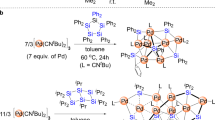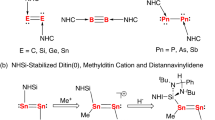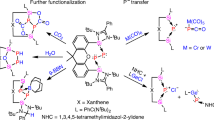Abstract
Open-shell molecules with unpaired electrons and a high-spin S ≥ 1 configuration are of fundamental importance in chemistry, biology and molecular electronics. Among metal-free systems, carbon- and silicon-based triplet diradicals with two unpaired electrons and strong ferromagnetic coupling are proposed as key intermediates in many organic and organometallic transformations but their isolation remains challenging due to their very high reactivity. Here we report the facile synthesis of isolable 1,3-disilapyrroles which act as organosilicon-based delocalized triplet diradicals. The 1,3-disilapyrroles result from cycloaddition reactions of two divalent silicon atoms in a N,N-bis(silylenyl)aniline to the carbon–carbon triple bond of diphenylacetylenes. Remarkably, the spin-density distribution of these triplet diradicals exhibits an asymmetric delocalization due to steric congestion. The unpaired electrons in the 1,3-disilapyrroles show unprecedented reactivity, including cyclotetramerization and cleavage of the carbon–oxygen triple bond of CO at ambient temperature with subsequent C(sp3)–H bond activation to give a polycyclic product.

This is a preview of subscription content, access via your institution
Access options
Subscribe to this journal
Receive 12 digital issues and online access to articles
$119.00 per year
only $9.92 per issue
Buy this article
- Purchase on Springer Link
- Instant access to full article PDF
Prices may be subject to local taxes which are calculated during checkout





Similar content being viewed by others
Data availability
Crystallographic data for the structures reported in this Article have been deposited at the Cambridge Crystallographic Data Centre under deposition numbers CCDC 2211907 (3), 2211908 (4), 2211909 (2F), 2211910 (2H), 2211911 (t1), 2211912 (6), 2211913 (5), 2211914 (t2F), 2211915 (t2H) and 2211916 ((2H)4). Copies of the data can be obtained free of charge via https://www.ccdc.cam.ac.uk/structures/. Additional synthetic methods, NMR spectra, cyclic voltammetry data, single-crystal X-ray diffraction data, EPR spectra, magnetism data and computational details are available in the Supplementary Information.
References
Fatila, E. M. et al. Fine-tuning the single-molecule magnet properties of a [Dy(III)-radical]2 pair. J. Am. Chem. Soc. 135, 9596–9599 (2013).
Caneschi, A. et al. Cobalt(II)–nitronyl nitroxide chains as molecular magnetic nanowires. Angew. Chem. Int. Ed. 40, 1760–1763 (2001).
Gatteschi, D. & Sessoli, R. Quantum tunneling of magnetization and related phenomena in molecular materials. Angew. Chem. Int. Ed. 42, 268–297 (2003).
Chandra Mondal, K., Roy, S. & Roesky, H. W. Silicon based radicals, radical ions, diradicals and diradicaloids. Chem. Soc. Rev. 45, 1080–1111 (2016).
Turmanskii, B., Karni, M. & Apeloig, Y. in Organosilicon Compounds: Theory and Experiment (ed. Lee, V. Ya.) 232–287 (Elsevier, 2017).
Power, P. P. Persistent and stable radicals of the heavier main group elements and related species. Chem. Rev. 103, 789–810 (2003).
Abe, M., Ye, J. & Mishima, M. The chemistry of localized singlet 1,3-diradicals (biradicals): from putative intermediates to persistent species and unusual molecules with a π-single bonded character. Chem. Soc. Rev. 41, 3808–3820 (2012).
Abe, M. Diradicals. Chem. Rev. 113, 7011–7088 (2013).
Kundu, S., Sinhababu, S., Chandrasekhar, V. & Roesky, H. W. Stable cyclic (alkyl)(amino)carbene (cAAC) radicals with main group substituents. Chem. Sci. 10, 4727–4741 (2019).
Feng, Z., Tang, S., Su, Y. & Wang, X. Recent advances in stable main group element radicals: preparation and characterization. Chem. Soc. Rev. 51, 5930–5973 (2022).
Niecke, E., Fuchs, A., Baumeister, F., Nieger, M. & Schoeller, W. W. A P2C2 four-membered ring with unusual bonding—synthesis, structure, and ring opening of a 1,3-diphosphacyclobutane-2,4-diyl. Angew. Chem. Int. Ed. 34, 555–557 (1995).
Takeuchi, K., Ichinohe, M. & Sekiguchi, A. Access to a stable Si2N2 four-membered ring with non-Kekulé singlet biradical character from a disilyne. J. Am. Chem. Soc. 133, 12478–12481 (2011).
Zhang, S. H. et al. Synthesis and characterization of a singlet delocalized 2,4-diimino-1,3-disilacyclobutanediyl and a silylenylsilaimine. Chem. Eur. J. 18, 4258–4263 (2012).
Scheschkewitz, D. et al. Singlet diradicals: from transition states to crystalline compounds. Science 295, 1880–1881 (2002).
Cui, C., Brynda, M., Olmstead, M. M. & Power, P. P. Synthesis and characterization of the non-Kekulé, singlet biradicaloid Ar′Ge(μ-NSiMe3)2 GeAr′ (Ar′ = 2,6-Dipp2C6H3, Dipp = 2,6-i-Pr2C6H3). J. Am. Chem. Soc. 126, 6510–6511 (2004).
Cox, H., Hitchcock, P. B., Lappert, M. F. & Pierssens, L. J.-M. A 1,3-diaza-2,4-distannacyclobutanediide: synthesis, structure, and bonding. Angew. Chem. Int. Ed. 43, 4500–4504 (2004).
Sen, S. S. et al. Synthesis, structure, and theoretical investigation of amidinato supported 1,4-disilabenzene. Chem. Commun. 46, 5873–5875 (2010).
Yeong, H. X., Xi, H. W., Lim, K. H. & So, C. W. Synthesis and characterization of an amidinate-stabilized cis-1,2-disilylenylethene [cis-LSi{C(Ph) = C(H)}SiL] and a singlet delocalized biradicaloid [LSi(μ2-C2Ph)2SiL]. Chem. Eur. J. 16, 12956–12961 (2010).
Chen, Y. et al. Stable radical cation and dication of a 1,4-disilabenzene. J. Am. Chem. Soc. 143, 2212–2216 (2021).
Mondal, K. C. et al. Conversion of a singlet silylene to a stable biradical. Angew. Chem. Int. Ed. 52, 1801–1805 (2013).
Mondal, K. C., Dittrich, B., Maity, B., Koley, D. & Roesky, H. W. Cyclic alkyl(amino) carbene stabilized biradical of disilicontetrachloride. J. Am. Chem. Soc. 136, 9568–9571 (2014).
Kundu, S. et al. Organosilicon radicals with Si–H and Si–Me bonds from commodity precursors. J. Am. Chem. Soc. 139, 11028–11031 (2017).
Maiti, A. et al. CAAC‐based Thiele and Schlenk hydrocarbons. Angew. Chem. Int. Ed. 59, 6729–6734 (2020).
Maiti, A., Chandra, S., Sarkar, B. & Jana, A. Acyclic diaminocarbene-based Thiele, Chichibabin, and Müller hydrocarbons. Chem. Sci. 11, 11827–11833 (2020).
Nayak, M. K. et al. A bis-NHC–CAAC dimer derived dicationic diradical. Chem. Sci. 13, 12533–12539 (2022).
Nozawa, T., Nagata, M., Ichinohe, M. & Sekiguchi, A. Isolable p- and m-[(tBu2MeSi)2Si]2C6H4: disilaquinodimethane vs triplet bis(silyl radical). J. Am. Chem. Soc. 133, 5773–5775 (2011).
Shan, C., Yao, S. & Driess, M. Where silylene–silicon centres matter in the activation of small molecules. Chem. Soc. Rev. 49, 6733–6754 (2020).
Xiong, Y., Yao, S., Ruzicka, A. & Driess, M. Distinctly different reactivity of bis(silylenyl)- versus phosphanyl-silylenyl-substituted o-dicarborane towards O2, N2O and CO2. Chem. Commun. 57, 5965–5968 (2021).
Wang, Y., Szilvási, T., Yao, S. & Driess, M. A bis(silylene)-stabilized diphosphorus compound and its reactivity as a monophosphorus anion transfer reagent. Nat. Chem. 12, 801–808 (2020).
Wang, Y. et al. Silicon-mediated selective homo- and heterocoupling of carbon monoxide. J. Am. Chem. Soc. 141, 626–634 (2019).
Xiong, Y. et al. An isolable 2,5‐disila‐3,4‐diphosphapyrrole and a conjugated Si=P−Si=P−Si=N chain through degradation of white phosphorus with a N,N ‐bis(silylenyl)aniline. Angew. Chem. Int. Ed. 61, e202209250 (2022).
Szczepanik, D. W. et al. The electron density of delocalized bonds (EDDB) applied for quantifying aromaticity. Phys. Chem. Chem. Phys. 19, 28970–28981 (2017).
von Ragué Schleyer, P. et al. Nucleus-independent chemical shifts: a simple and efficient aromaticity probe. J. Am. Chem. Soc. 118, 6317–6318 (1996).
Menéndez, M. et al. One-electron images in real space: natural adaptive orbitals. J. Comput. Chem. 36, 833–843 (2015).
Zhang, J. X., Sheong, F. K. & Lin, Z. Unravelling chemical interactions with principal interacting orbital analysis. Chem. Eur. J. 24, 9639–9650 (2018).
Yao, S. et al. Bis(silylene)-stabilized monovalent nitrogen complexes. Angew. Chem. Int. Ed. 59, 22043–22047 (2020).
J. A. Berson, in Reactive Intermediate Chemistry (eds Moss, R. A., Platz, M. S. & Jones, M., Jr) Ch. 5 (Wiley, 2004); https://doi.org/10.1002/0471721492.ch5
Fujimori, S. & Inoue, S. Carbon monoxide in main-group chemistry. J. Am. Chem. Soc. 144, 2034–2050 (2022).
Ganesamoorthy, C. et al. A silicon–carbonyl complex stable at room temperature. Nat. Chem. 12, 608–614 (2020).
Reiter, D., Holzner, R., Porzelt, A., Frisch, P. & Inoue, S. Silylated silicon–carbonyl complexes as mimics of ubiquitous transition-metal carbonyls. Nat. Chem. 12, 1131–1135 (2020).
Cowley, M. J. et al. Carbonylation of cyclotrisilenes. Angew. Chem. Int. Ed. 52, 13247–13250 (2013).
Garg, P. et al. Activation of CO using a 1,2‐disilylene: facile synthesis of an abnormal N‐heterocyclic silylene. Angew. Chem. Int. Ed. 61, e202201705 (2022).
Xiong, Y., Yao, S., Szilva, T., Ruzicka, A. & Driess, M. Homocoupling of CO and isocyanide mediated by a C,C′-bis(silylenyl)-substituted ortho-carborane. Chem. Commun. 56, 747–750 (2020).
Majumdar, M. et al. Reductive cleavage of carbon monoxide by a disilenide. Angew. Chem. Int. Ed. 54, 8746–8750 (2015).
Protchenko, A. V. et al. Reduction of carbon oxides by an acyclic silylene: reductive coupling of CO. Angew. Chem. Int. Ed. 58, 1808–1812 (2019).
Sen, S. S., Roesky, H. W., Stern, D., Henn, J. & Stalke, D. High yield access to silylene RSiCl (R = PhC(NtBu)2) and its reactivity toward alkyne: synthesis of stable disilacyclobutene. J. Am. Chem. Soc. 132, 1123–1126 (2010).
Bain, G. A. & Berry, J. F. Diamagnetic corrections and Pascal’s constants. J. Chem. Educ. 85, 532–536 (2008).
Sheldrick, G. M. SHELXT—integrated space-group and crystal-structure determination. Acta Crystallogr. A 71, 3–8 (2015).
Bourhis, L. J., Dolomanov, O. V., Gildea, R. J., Howard, J. A. K. & Puschmann, H. The anatomy of a comprehensive constrained, restrained refinement program for the modern computing environment—Olex2 dissected. Acta Crystallogr. A 71, 59–75 (2015).
Dolomanov, O. V., Bourhis, L. J., Gildea, R. J., Howard, J. A. K. & Puschmann, H. OLEX2: a complete structure solution, refinement and analysis program. J. Appl. Crystallogr. 42, 339–341 (2009).
Frisch, M. J. et al. Gaussian 16, revision A.03 (Gaussian, 2016).
Becke, A. D. Density-functional thermochemistry. III. The role of exact exchange. J. Chem. Phys. 98, 5648–5652 (1993).
Weigend, F. & Ahlrichs, R. Balanced basis sets of split valence, triple zeta valence and quadruple zeta valence quality for H to Rn: design and assessment of accuracy. Phys. Chem. Chem. Phys. 7, 3297–3305 (2005).
Zheng, J., Xu, X. & Truhlar, D. G. Minimally augmented Karlsruhe basis sets. Theor. Chem. Acc. 128, 295–305 (2010).
Papajak, E. et al. Perspectives on basis sets beautiful: seasonal plantings of diffuse basis functions. J. Chem. Theory Comput. 7, 3027–3034 (2011).
Wiberg, K. B. Application of the Pople–Santry–Segal CNDO method to the cyclopropylcarbinyl and cyclobutyl cation and to bicyclobutane. Tetrahedron 24, 1083–1096 (1968).
Glendening, E. D. et al. NBO 7.0 (Theoretical Chemistry Institute, University of Wisconsin, 2013); http://nbo7.chem.wisc.edu/
Lu, T. & Chen, F. Multiwfn: a multifunctional wavefunction analyzer. J. Comput. Chem. 33, 580–592 (2012).
Legault, C. Y. CYLview, 1.0b edn (Université de Sherbrooke, Sherbrooke, 2009); http://www.cylview.org
Humphrey, W., Dalke, A. & Schulten, K. VMD: visual molecular dynamics. J. Mol. Graphics 14, 33–38 (1996).
Johnson, E. R. et al. Revealing noncovalent interactions. J. Am. Chem. Soc. 132, 6498–6506 (2010).
Acknowledgements
This work was funded by the DFG (German Research Foundation) under Germany´s Excellence Strategy–EXC 2008–390540038–UniSysCat for S.Y., C. Lorent, K.B.K., G.V., C. Limberg and M.D., and DR-226/21-1 for Y.X., S.Y., M.D., and the National Science Foundation of China (21873079) for S.D. and J.Z.
Author information
Authors and Affiliations
Contributions
Synthesis and X-ray diffraction analyses were performed by Y.X. and S.Y., and supervised by M.D. EPR experiments were performed and analysed by C. Lorent. Magnetic susceptibility measurements were performed and analysed by K.B.K. and C. Limberg. Cyclic voltammetry measurements were performed and analysed by G.V. DFT calculations and computational analysis were performed by S.D. and J.Z. The manuscript was written by Y.X., S.Y., M.D., and edited by all the authors.
Corresponding author
Ethics declarations
Competing interests
The authors declare no competing interests.
Peer review
Peer review information
Nature Synthesis thanks Milan Gembicky, Dietmar Stalke and the other, anonymous, reviewer(s) for their contribution to the peer review of this work. Primary handling editor: Alison Stoddart, in collaboration with the Nature Synthesis team.
Additional information
Publisher’s note Springer Nature remains neutral with regard to jurisdictional claims in published maps and institutional affiliations.
Extended data
Extended Data Fig. 1 Spin population of 2H, t2H, t2F, 2-Ph, 2-Me, and 2-H.
a. Spin population of 2H, t2H, and t2F (red numbers, triplet) shows asymmetric spin density distribution. b. Spin population of 2-Ph, 2-Me, and 2-H shows nearly or completely symmetric spin density distribution. Hydrogen atoms in 3D structures are omitted for clarity. isovalue = 0.005 a.u.
Extended Data Fig. 2 NAdO analysis on the bonding modes of 2F2+.
a. NAdO analysis on the Si1-C3 bonding modes of 2F2+, b. NAdO analysis on the C3-C4 bonding modes of 2F2+, c. NAdO analysis on the C4-Si2 bonding modes of 2F2+, d. NAdO analysis on the Si2-N5 bonding modes of 2F2+, e. NAdO analysis on the Si1-N5 bonding modes of 2F2+. isovalue = 0.05 a.u.
Supplementary information
Supplementary Information
Synthetic methods, NMR spectra, cyclic voltammetry data, single-crystal X-ray diffraction data, EPR spectra, magnetism data and computational details including Supplementary Figs. 1–47 and Tables 1–26.
Supplementary Data 1
Crystal data for compound t1, CCDC 2211911
Supplementary Data 2
Crystal data for compound 2H, CCDC 2211910
Supplementary Data 3
Crystal data for compound 2F, CCDC 2211909
Supplementary Data 4
Crystal data for compound t2H, CCDC 2211915
Supplementary Data 5
Crystal data for compound t2F, CCDC 2211914
Supplementary Data 6
Crystal data for compound (2H)4, CCDC 2211916
Supplementary Data 7
Crystal data for compound 3, CCDC 2211907
Supplementary Data 8
Crystal data for compound 4, CCDC 2211908
Supplementary Data 9
Crystal data for compound 5, CCDC 2211913
Supplementary Data 10
Crystal data for compound 6, CCDC 2211912
Supplementary Data 11
Fig 1: Curie plot of the half-field transition from 2H, 2F, t2H and t2F; Fig 2: EPR spectra of 2F and 2F+; Fig 3: Magnetic susceptibility of 4; Fig 5: Cyclic voltammetry of 2F
Source data
Source Data Fig. 5
Source data of Figure 5
Rights and permissions
Springer Nature or its licensor (e.g. a society or other partner) holds exclusive rights to this article under a publishing agreement with the author(s) or other rightsholder(s); author self-archiving of the accepted manuscript version of this article is solely governed by the terms of such publishing agreement and applicable law.
About this article
Cite this article
Xiong, Y., Dong, S., Yao, S. et al. A class of non-aromatic 1,3-disilapyrroles acting as stable organosilicon-based triplet diradicals. Nat. Synth 2, 678–687 (2023). https://doi.org/10.1038/s44160-023-00279-6
Received:
Accepted:
Published:
Issue Date:
DOI: https://doi.org/10.1038/s44160-023-00279-6



